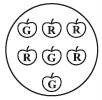Exercise 4.3 Page: 87
1. List the outcomes you can see in these experiments.
(a) Spinning a wheel (b) Tossing two coins together

Solution:
(a) There are four letters A, B, C and D in a spinning wheel. So there are 4 outcomes.
(b) When two coins are tossed together. There are four possible outcomes HH, HT, TH, TT.
2. When a die is thrown, list the outcomes of an event of getting
(i) (a) a prime number (b) not a prime number.
(ii) (a) a number greater than 5 (b) a number not greater than 5.
Solution:
(i) (a) Outcomes of event of getting a prime number are 2, 3 and 5.
(b) Outcomes of event of not getting a prime number are 1, 4 and 6.
(ii) (a) Outcomes of event of getting a number greater than 5 is 6.
(b) Outcomes of event of not getting a number greater than 5 are 1, 2, 3, 4 and 5.
3. Find the.
(a) Probability of the pointer stopping on D in (Question 1-(a)).
(b) Probability of getting an ace from a well shuffled deck of 52 playing cards.
(c) Probability of getting a red apple. (See figure below)

Solution:
(a) In a spinning wheel, there are five pointers A, A, B, C, D. So there are five
outcomes. Pointer stops at D which is one outcome.
So the probability of the pointer stopping on D = 1/5
(b) There are 4 aces in a deck of 52 playing cards. So there are four events of getting an ace.
So, probability of getting an ace = 4/52 = 1/13
(c) Total number of apples = 7
Number of red apples = 4
Probability of getting red apple = 4/7
4. Numbers 1 to 10 are written on ten separate slips (one number on one slip), kept in a box and mixed well. One slip is chosen from the box without looking into it. What is the probability of .
(i) getting a number 6?
(ii) getting a number less than 6? (iii) getting a number greater than 6? (iv)getting a 1-digit number?
Solution:
(i) Outcome of getting a number 6 from ten separate slips is one.
∴, probability of getting a number 6 = 1/10
(ii) Numbers less than 6 are 1, 2, 3, 4 and 5 which are five. So there are 5 outcomes.
∴, probability of getting a number less 6 =5/10 = ½
(iii)Number greater than 6 out of ten that are 7, 8, 9, 10. So there are 4 possible outcomes.
∴, probability of getting a number greater than 6 = 4/10 = 2/5
(iv) One digit numbers are 1, 2, 3, 4, 5, 6, 7, 8, 9 out of ten.
∴, probability of getting a 1-digit number = 9/10
5. If you have a spinning wheel with 3 green sectors, 1 blue sector and 1 red sector, what is the probability of getting a green sector? What is the probability of getting a non-blue sector?
Solution:
A total of five sectors are present.
Out of the five sectors, three sectors are green.
∴, probability of getting a green sector = 3/5
Out of the five sectors, one sector is blue. Hence, Non-blue sectors = 5 – 1 = 4 sectors
∴, probability of getting a non-blue sector= 4/5
6. Find the probabilities of the events given in Question 2.
Solution:
When a die is thrown, there are total six outcomes, i.e., 1, 2, 3, 4, 5 and 6.
(i)
(a) 2, 3, 5 are the prime numbers. So there are 3 outcomes out of 6.
∴,probability of getting a prime number =3/6 = ½
(b) 1, 4, 6 are not the prime numbers. So there are 3 outcomes out of 6.
∴,probability of getting a prime number =3/6 = ½
(ii)
(c) Only 6 is greater than 5.
So there is one outcome out of 6.
∴,probability of getting a number greater than 5= 1/6
(d) Numbers not greater than 5 are 1, 2, 3, 4 and 5. So there are 5 outcomes out of 6.
∴,probability of not getting a number greater than 5= 5/6